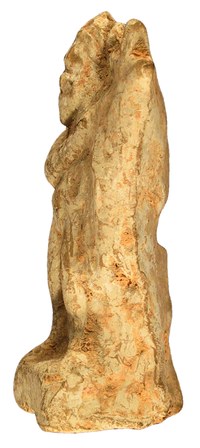Actor with kithara
|
Actor with kithara, Inv. T I-21 Hollow. Front from the mould, back not finished, slightly domed, fleetingly smoothed and with large triangular kilning hole. Beige clay(7.5YR 7/4), abundant white engobe. Traces of pink paint on the clothing, on the face as well as on the instrument. Provenance: Unknown; Athens Art Trade. Acquired by Bruno Sauer with special funds for the university anniversary in 1907. State of preservation: Nose broken off. Bumps on the right hand, in the hair, on the plinth and on the back at the kilning hole, two wider and one longer fine crack at the top and along the seam to the front. Sintered. Maße: H: 9,5 cm; W: 5,6 cm; D: 2,8 cm, am Sockel 3,8 cm. Lit.: M. Recke, Antike Kunst aus der Antikensammlung der Justus-Liebig-Universität (Gießen 2010) 23 no. 47. |
Description: A bearded man stands on a roughly square plinth, the kithara[1] at his left side. A cloth with a pointed tip hangs down from the instrument. The player is facing the viewer; only his left leg is turned outwards, in profile view. The right arm, reaching out across the chest, reaches the kithara, but the hand and fingers, which should be hitting the strings[2], can no longer be delineated. Artificial, untied genitals are attached to the short leotard[3]. The mantle, which is also pulled over the head, falls down on both sides as a narrow hem to the plinth.
In a flat curve, a thick bulge of hair borders the high forehead. The small eyes are close together. Only the outline of the nose remains. A moustache frames the broad and open mouth. The chin is covered by a triangular-shaped goatee.
Commentary: The figure of the masked kithara player resembles a statuette in the Kunsthistorisches Museum in Vienna, inv. no. V 1825. The well-preserved comparative example is listed by Körte and illustrated by Winter[4]. The "washed-out specimen" no. 51, also mentioned by Körte, is probably the statuette T I-21, which was in the Athens art trade at the time and is now in Giessen. Another actor figure in the art trade resembles these two[5]. It differs slightly in posture; the head is turned slightly to the right. One can recognise the right hand and the fingers grasping the thick strings of the strings, as well as the left hand grasping the upper edge of the instrument. A kind of diadem separates the ruffled hair from the high, transversely furrowed forehead. The beard is streaked lengthwise.
The short robe showing off the genitals and the pointed triangular beard belong to the props of the Old Comedy, but, as M. Bieber shows[6], they were still retained when the development of the dramatis personae towards a more individual characterisation of the New Comedy began[7]. In contrast to the round-plasticised actor-figures of the Middle Comedy in New York[8], the Giessen Kithara player and its parallels are entirely frontal. T I-21was probably conceived towards the end of the 4th century BC. Boeotia (Tanagra) is considered the landscape of origin for the comparative pieces. The light clay colour of the Giessen example matches this.
Determination: 320/310 BC; from a Boeotian workshop.
 |
 |
 |
|---|
[1] Otherwise consistently referred to as lyre, M. Bieber, The History of the Greek and Roman Theater (Princeton 2.Aufl. 1961) 43; A. Pickard-Cambridge, The Dramatic Festivals of Athens (Oxford 31988) 165-166; T. B. L. Webster, Monuments Illustrating Old and Middle Comedy (London 1969) 46 no. AT 90.
[2] On this gesture, see also Apollo Kitharoides, B. Vierneisel- Schlörb, Kerameikos 15, Die figürlichen Terrakotten (München 1997) 47 no. 141 pl. 27, 1.4; furthermore, a kithara-playing Eros in Leipzig, E. Paul, Antike Welt in Ton (Leipzig 1959) 89 no. 236 pl. 64.
[3] H. Froning, Theater-Terrakotten. Aus der Antikensammlung des Archäologischen Seminars der Philipps-Universität (Marburg 1993/94) 24.
[4] A. Körte, Archäologische Studien zur alten Komödie, JdI 8, 1893, 81 no. 50; Winter 2 1903, 417, 8. Webster mentions three examples: besides Wien Inv. 1825, Körte no. 50 from Tanagra in the Lecuyer Collection and Körte No. 51 from Boeotia, in the Athens Art Trade, id. 1969, 46, AT 90.
[5] St. Ohlig, Kunstwerke der Antike, Antikenkabinett Bernd Gackstätter, Frankfurt am Main, Ausstellung 14.-28. April 2007, 32-33, no. 31.
[6] Bieber ibid. 45-48 fig. 185-198.
[7] Bieber ibid. 48.
[8] "The backs are as finely executed as the fronts", Bieber ibid. 46.

